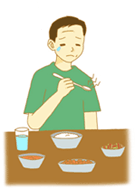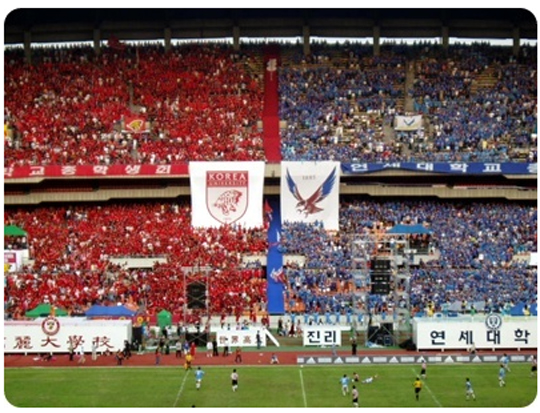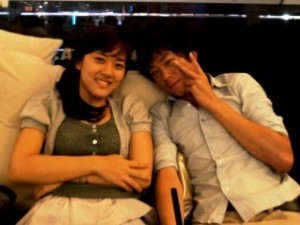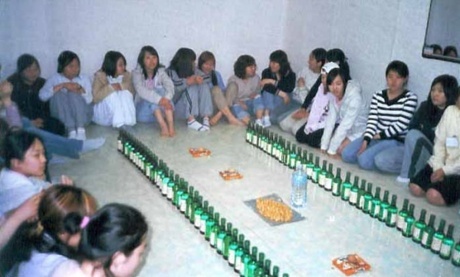By Elena J. (with insights from Angel R.)
 Similar to the majority of 600,000 students that took the Korean College Entrance Exams last year, I held an image of college life that was a crude botch of images glued together by the media and tales from incumbent college students. College was a place where one could party, drink all night, throw up, and still look as glamorous as Jun Ji-Hyun did in “My Sassy Girl.” Girls would finally be able to wear heels, makeup, and get a perm, whereas guys would be able to dye their hair and drink to their heart’s content—indulgences prohibited for them until now. College also seemed like a place of absolution—once they had the acceptance letter in front of their eyes, most parents would relent to anything. ANYTHING—from fancy European tours to an expensive new wardrobe, because for Korean parents, having kids in college (and a “good” one in the capital city) contributes greatly to family honor, elevates the child’s social status later in life, and never fails to arouse envy among the ajummas at the local jjimjilbang.
Similar to the majority of 600,000 students that took the Korean College Entrance Exams last year, I held an image of college life that was a crude botch of images glued together by the media and tales from incumbent college students. College was a place where one could party, drink all night, throw up, and still look as glamorous as Jun Ji-Hyun did in “My Sassy Girl.” Girls would finally be able to wear heels, makeup, and get a perm, whereas guys would be able to dye their hair and drink to their heart’s content—indulgences prohibited for them until now. College also seemed like a place of absolution—once they had the acceptance letter in front of their eyes, most parents would relent to anything. ANYTHING—from fancy European tours to an expensive new wardrobe, because for Korean parents, having kids in college (and a “good” one in the capital city) contributes greatly to family honor, elevates the child’s social status later in life, and never fails to arouse envy among the ajummas at the local jjimjilbang.
However, during my first semester in college, I find college as grueling as, if not more, than high school. As a commuting student, on days in which I have classes at first period 9 A.M., I nearly suffocate on the subway (Line 2, aka “the Line of Death”) jam-packed with people on their way to work. Though the lights of Shinchon and upperclassmen often beckon us freshmen to come out and enjoy the night, our workload often forces us to head straight home or to the library. Still, the campus is filled with vivacity and freedom that high school had greatly lacked. The ten points below, based on my observations and experience, are part of a candid record and hopefully, to future students, a possible guide on surviving the first semester at a Korean university.
1. Dress to Kill
Dressing nicely is important for people anywhere, everywhere. However, Korean college students have redefined the meaning of “looking nice.” Clad with designer bags, high heels, and short skirts, many female Korea n university students make university streets seem like catwalks. Plastic surgery is also very common among the female students, such as the “Ssankapul” or double eyelid surgery, along with excessive dieting, the latest fad for guys and girls alike. While working on my history paper at the library a few weeks before the midterms, I ran into one of my old high school friends that also attend Yonsei. I must have looked pretty haggard, as he looked at me with amusement and praised the “Americanness” of my appearance—for joking someone looks like an “American university student” is actually a subtle reference to one’s carelessness in appearance— in many Korean students’ minds, an “American student” most often wears faded jeans with a t-shirt, and always lugging an over-sized backpack. Though many Americans do not dress in this manner, many Koreans, especially young Koreans, think of American university life as the opposite to that of Korean universities, but more similar to their high school life, when many students are forced to remain rather indifferent to their appearance due to the long hours of study.
n university students make university streets seem like catwalks. Plastic surgery is also very common among the female students, such as the “Ssankapul” or double eyelid surgery, along with excessive dieting, the latest fad for guys and girls alike. While working on my history paper at the library a few weeks before the midterms, I ran into one of my old high school friends that also attend Yonsei. I must have looked pretty haggard, as he looked at me with amusement and praised the “Americanness” of my appearance—for joking someone looks like an “American university student” is actually a subtle reference to one’s carelessness in appearance— in many Korean students’ minds, an “American student” most often wears faded jeans with a t-shirt, and always lugging an over-sized backpack. Though many Americans do not dress in this manner, many Koreans, especially young Koreans, think of American university life as the opposite to that of Korean universities, but more similar to their high school life, when many students are forced to remain rather indifferent to their appearance due to the long hours of study.
2. Eating alone = social suicide?
Though eating alone is common scene in many American university cafeterias, Korean students fear eating alone as it supposedly blatantly reveals of one’s antisocial tendencies. Sitting alone at a table is especially inadvi sable for freshmen who should socialize with friends or ask their Sunbaes (upperclassmen) for a free lunch. Sometime in March, when I asked one of my friends if she had eaten lunch, she made the mistake of saying (a bit too loudly) that she had eaten alone. Friends nearby who overheard her reply instantly showed signs of shock and even graciously offered their sympathies. Many Koreans learn from an early age to socialize, and the best time to do so is through a meal. Throughout primary and secondary school, Korean children learn to eat with their friends, even if they do not want to be with them all the time because eating alone could possibly make one an easy target for bullying or being branded as a loner.
sable for freshmen who should socialize with friends or ask their Sunbaes (upperclassmen) for a free lunch. Sometime in March, when I asked one of my friends if she had eaten lunch, she made the mistake of saying (a bit too loudly) that she had eaten alone. Friends nearby who overheard her reply instantly showed signs of shock and even graciously offered their sympathies. Many Koreans learn from an early age to socialize, and the best time to do so is through a meal. Throughout primary and secondary school, Korean children learn to eat with their friends, even if they do not want to be with them all the time because eating alone could possibly make one an easy target for bullying or being branded as a loner.
3. Ask and you shall receive
This maxim stands true for freshmen. First year students have the privilege of asking their Sunbaes for a free meal. Often when a freshman becomes acquainted with a new Sunbae or meets one they know, the Sunbaes ask their Hubaes (underclassmen) to give them a call to eat lunch together. Surprisingly, many of these requests are sincere, for if you do not call, the next time you see an upperclassman, he or she will seem concerned and will ask you why you did not give them a call beforehand. This is an example of Korean 내리사랑 (pronounced naeri-sarang), or, roughly translated, “descending love,” in which the elder bestows love to the younger person, and that younger person pays it forward to the younger generation. Freshmen receive all the love they can receive while they are the youngest of the school, but once sophomores, they would have to repay the favors by benefiting the new, younger students. However, buying food for Hubaes is also a sign that the Sunbaes do not want to feel ostracized—many Sunbaes talk about who they bought lunch for amongst themselves. Sometimes the number of the meals bought for underclassmen or for whom they bought lunch certifies a Sunbae’s popularity amongst the lowerclassmen.
4. “SPECS” get you further along in life than your GPA can?
Though the Yonsei Samsung Library bursts with students during exam season, students are always waiting in line to obtain a seat at the reading rooms. In these rooms, however, I often see more CPA, TOEIC, and TOEFL workbooks than College physics or biology textbooks on the desks. Specs, the Konglish abbreviation of the English word “specifications,” which refers to the “requirements or qualifications of a product,” serve as one of the  biggest goals to be achieved during college. Many Korean college students prepare as much for certifications for future resumes, if not more, than for their upcoming midterms and finals. A few of my best friends are even willing to take a leave of absence just to prepare for a government official exam or a TOEFL exam. During dinner, my parents, as with many other parents, sometimes slip in advice on taking the Foreign Service Exam, one of the biggest national exams, or 고시 “Goshi” exams, which are so competitive that “Goshi Villages,” shantytowns filled with cram schools and one room apartments for the students, can be found around Seoul. Sadly for some, these scores may lead to more success in the job market than can their grades and true interests.
biggest goals to be achieved during college. Many Korean college students prepare as much for certifications for future resumes, if not more, than for their upcoming midterms and finals. A few of my best friends are even willing to take a leave of absence just to prepare for a government official exam or a TOEFL exam. During dinner, my parents, as with many other parents, sometimes slip in advice on taking the Foreign Service Exam, one of the biggest national exams, or 고시 “Goshi” exams, which are so competitive that “Goshi Villages,” shantytowns filled with cram schools and one room apartments for the students, can be found around Seoul. Sadly for some, these scores may lead to more success in the job market than can their grades and true interests.
5. One Shot! [Table Manners]
One shot is all you’ve got to make an impression in a dinner outing with your Sunbaes. Drinking is one of the most common ways to bond with upperclassmen and fellow classmen without worrying about manners and frills. The only manners to worry about are drinking manners. When receiving a glass of alcohol from an elder, never reject it, don’t forget to hold the glass with both hands, and always drink all that has been given to  you. A symbol of fellowship and a form of etiquette, drinking plays a big role in shaping one’s image and determining one’s membership in a group. Drinking games are popular methods for breaking the ice among the Sunbaes and Hubaes. Instead of games such as Beer Bong which requires a lot of physical endurance, Korean drinking games require a lot of brains. From classic games such as “369” (in which everyone counts up, clapping once instead of stating any number that includes a 3, 6, or 9) to games such as “Hitting the bottle cap” (everyone takes a turn flicking the wire on the Soju cap; whoever succeeds in removing the wire has to drink) and the “Baskin Robbins 31” game (again, counting up, but this time, to 31. One person may call out one to three numbers. Fairly easy, but an easy way to create a target). Though these games may seem a bit too juvenile, staying alert is crucial, for many Korean drinking games require precision and acumen, and losing means consuming even more alcohol…Good news for women—there is usually a “black knight,” a knight in shining armor who chivalrously drinks the alcohol for the lady who cannot take the punishment on her own. However, a catch exists—the female should return the favor in the form of a wish from her knight be it a song, a dance, or even a quick peck on the cheek. It’s probably best to take responsibility for your regressions in the first place.
you. A symbol of fellowship and a form of etiquette, drinking plays a big role in shaping one’s image and determining one’s membership in a group. Drinking games are popular methods for breaking the ice among the Sunbaes and Hubaes. Instead of games such as Beer Bong which requires a lot of physical endurance, Korean drinking games require a lot of brains. From classic games such as “369” (in which everyone counts up, clapping once instead of stating any number that includes a 3, 6, or 9) to games such as “Hitting the bottle cap” (everyone takes a turn flicking the wire on the Soju cap; whoever succeeds in removing the wire has to drink) and the “Baskin Robbins 31” game (again, counting up, but this time, to 31. One person may call out one to three numbers. Fairly easy, but an easy way to create a target). Though these games may seem a bit too juvenile, staying alert is crucial, for many Korean drinking games require precision and acumen, and losing means consuming even more alcohol…Good news for women—there is usually a “black knight,” a knight in shining armor who chivalrously drinks the alcohol for the lady who cannot take the punishment on her own. However, a catch exists—the female should return the favor in the form of a wish from her knight be it a song, a dance, or even a quick peck on the cheek. It’s probably best to take responsibility for your regressions in the first place.
![lunapic_129750201267296_[1]](http://thethreewisemonkeys.com/wp-content/uploads/2010/09/lunapic_129750201267296_1.jpg)
6. 과제중… “Doing Assignments…”
Although Korean college life is famous for the excessive drinking and partying, student life does not always revolve around these activities. Studying mostly in high school and partying in college is an anachronistic dichotomy, a tale from our parents’ era. 과제 (“work”) never fails to keep students busy. During the semester, 과제중…(pronounced gwa-jay-joong) stands as one of the most popular lines of the day on MSN or Nate On, (Korea’s most popular instant messaging program). Many Korean students, myself included, have had an especially hard time with hands-on projects, weekly reports, and group work that the courses demand because they had never done such work in high schools. Though most high school students study, study, study, this “studying” consists of rote memorization of facts in every subject, and does not require much cooperation or deep contemplation. Besides, Korean high school teachers leave homework to be assigned by the hakwons, or the private after-school academies. In this respect, many high schools fail to adequately prepare their students for higher education; many freshmen are badly informed about avoiding plagiarism and formulating bibliographies. What was once fine to copy and paste off of Google can now result in a failing grade.
7. Campus Festivals!
 Every spring, Korean universities hold their own festivals and concerts. Students are advised to wear the school color and be familiar with k-pop—as well as the school the school cheers—to fully enjoy the spring fling. Classes may end early during the few days of the festival (depending on the professor) and students take time to relax after midterms. The two biggest college festivals are those of Korea’s most infamous rival universities: Yonsei University’s AKARAKA and Korea University’s IPSILENTI. On the last day of Yonsei’s festival, some Korean University students clad in red t-shirts infiltrate Yonsei’s amphitheatre, an ocean of blue, and proudly cheer for their own alma mater. Though these cheers always meet with jeers from their Yonsei counterparts, everybody is in a good mood, and both crowds unite in their fervor in front of the performing celebrities. On the last day of the three day festival, each college department or club goes out to drink on campus and to have a good time.
Every spring, Korean universities hold their own festivals and concerts. Students are advised to wear the school color and be familiar with k-pop—as well as the school the school cheers—to fully enjoy the spring fling. Classes may end early during the few days of the festival (depending on the professor) and students take time to relax after midterms. The two biggest college festivals are those of Korea’s most infamous rival universities: Yonsei University’s AKARAKA and Korea University’s IPSILENTI. On the last day of Yonsei’s festival, some Korean University students clad in red t-shirts infiltrate Yonsei’s amphitheatre, an ocean of blue, and proudly cheer for their own alma mater. Though these cheers always meet with jeers from their Yonsei counterparts, everybody is in a good mood, and both crowds unite in their fervor in front of the performing celebrities. On the last day of the three day festival, each college department or club goes out to drink on campus and to have a good time.
8. “Mee-TINGs” and “So-gae-TINGs”
“Meetings,” in the Korean sense, are not just any equivalent to any gathering; they explicitly refer to group blind dates. Sogaetings are one-on-one blind dates, which sometimes can become more intimate or awkward. In a Meeting, one of the most popular events among freshmen, one mediator, or broker, introduces his or her group of friends to another group of friends of the opposite sex. The two groups meet for dinner, introduce themselves, and head for a bar after the meal. At the bar, everyone opts for drinks and after a few glasses, the mood lifts and people start to feel closer. Though some people may receive “Afters,” or continuous calls from a person who is interested, in general, meetings are considered very casual get-togethers. At women’s universities, however, meetings are sacred events that can never be missed. A friend from Ewha Women’s University joked about how some Ewha students nervously clench their phone during class waiting for a text message from a mediator recruiting new participants for a Meeting, usually based on a first-come-first-serve basis. At times, knowing basic information about the other group before the meeting is helpful, because sometimes rudimentary profiles help the most when meeting someone for the first time. For example, one who cannot drink so well would have to be wary of engineering or science majors. Meetings with science majors from Korea University, dubbed the “Makgeolli University,” would require some serious thought if one had classes the next day. While at a meeting with Seoul National University Engineering students, one of my best friends from high school ran out of the bar after only an hour, because she could not stand the Engineering majors’ pompous attitude towards any student that did not attend SNU. Though labeling and stereotyping is dangerous at times, f8un ways to get together and become acquainted with new people, Sogaetings and Meetings have become ingrained in Korean college culture.
9. Pre-frosh, MT
Similar to many English terms used in Korea, “MTs,” or “Membership Training” signifies a completely different event in Korea. A few weeks before the spring semester starts, Sunbaes and a few department professors take freshmen on a pre-frosh MT, in which freshmen become acquainted  amongst themselves and with their Sunbaes. There are group skit competitions, recreational activities, and most of all, heavy drinking. Sunbaes, comprised of mostly sophomores, haze freshmen with drinks mixed in punchbowls which they are required to drink down in one sitting. (Afterward, however, some Sunbaes help their younger brothers and sisters drain the alcohol out of their systems). Regular MTs that take place during the school year are not very different; they are similar to the U.S. frat party scenes full of partying, BBQ-grilling, and excessive drinking.
amongst themselves and with their Sunbaes. There are group skit competitions, recreational activities, and most of all, heavy drinking. Sunbaes, comprised of mostly sophomores, haze freshmen with drinks mixed in punchbowls which they are required to drink down in one sitting. (Afterward, however, some Sunbaes help their younger brothers and sisters drain the alcohol out of their systems). Regular MTs that take place during the school year are not very different; they are similar to the U.S. frat party scenes full of partying, BBQ-grilling, and excessive drinking.
10. College is what you make of it
Sometimes, while looking around the class during a lecture, I ask myself, “Was college really worth all those sleepless nights poring over textbooks and the endless note taking done all throughout high school? Have my family’s efforts and expectations come to fruition? What’s next??” During high school, college seemed like the end of my journey, the final destination. However, now I am forced to prepare for a career, to hone my skills to compete in the job market, and worry about my possible status as an old maid… Many assume that Korean college kids go on crazy drinking binges, party, and socialize—rights all denied to them until now. Though these assumptions hold true for many students, college, as well as any phase in life, does not fail to give life lessons and help an individual learn.
Like the Spanish saying, “Lo que en los libros no está, la vida te enseñará,” (That which the books do not teach you, life will), Korean students, and parents, should remember that life sometimes offers wisdom that can be obtained only through experience. For many Korean students, college may be the first step towards living a life full of responsibilities, choices, and enjoyment.
______________________________________________________________

Elena J. and Angel R. are currently freshmen at Yonsei University. Though both are quirky ENFPs that make up only 4% of the Korean population, they do not differ from typical Korean college students that seem to find creative inspiration mostly at coffee shops.
 Print This Post
Print This Post








